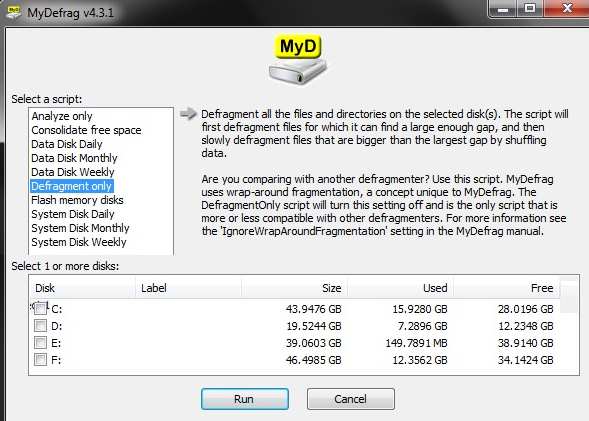


The process won't wake the computer to run. You might find that scheduled task hasn't defragmented all volumes. Because of that, the Last run time can be up to a month old. If you skip analysis, you won't see an updated Last run time in the Optimize Drives app. If you manually run traditional defragmentation on a SSD, between your normally scheduled runs, the next scheduled task run performs analysis and retrim, but skips traditional defragmentation on that SSD. Changing the frequency of the scheduled task does not affect the once per month cadence for the SSDs. However, if both traditional defragmentation and retrim are skipped, then analysis isn't run. Includes traditional defragmentation, for example moving files to make them reasonably contiguous and retrim. When run from the scheduled task, defrag uses the below policy guidelines for SSDs: As an Administrator, you can change the how often the task runs by using the Optimize Drives app. The defragmentation process runs scheduled task as a maintenance task, which typically runs every week. To defragment all volumes with normal priority and provide verbose output, type: defrag /c /h /v To perform a fragmentation analysis of a volume mounted on drive C and provide progress, type: defrag c: mountpoint /a /u To defragment the volumes on drives C and D in parallel in the background, type: defrag c: d: /m To defragment the volume on drive C while providing progress and verbose output, type: defrag c: /u /v Conversely, if you run the defrag command and open Disk defragmenter, the defragmentation options in Disk defragmenter are unavailable. If you are using Disk defragmenter to defragment a volume and you run the defrag command at a command-line, the defrag command fails. Running the defrag command and Disk defragmenter are mutually exclusive. To interrupt the defragmentation process, at the command line, press CTRL+C. For example: defrag volume /v > FileName.txt You can send the reports to a text file by typing > FileName.txt, where FileName.txt is a file name you specify. When defrag is finished analyzing and defragmenting the volume, it displays the analysis report, the defragmentation report, or both reports, and then exits to the command prompt.īy default, defrag displays a summary of both the analysis and defragmentation reports if you do not specify the /a or /v parameters. While defrag is analyzing and defragmenting a volume, it displays a blinking cursor.
WINDOWS 7 QUICK DISK DEFRAGMENTATION FREE
To increase the free space on a volume, delete unneeded files or move them to another disk. If a volume has less than 15% free space, defrag will only partially defragment it. defrag uses this space as a sorting area for file fragments. As a security best practice, consider using Run As to perform this procedure.Ī volume must have at least 15% free space for defrag to completely and adequately defragment it. If the computer is joined to a domain, members of the Domain Admins group might be able to perform this procedure. To perform this procedure, you must be a member of the Administrators group on the local computer, or you must have been delegated the appropriate authority. You can determine if a volume is dirty by using the fsutil dirty command.įile system volumes that aren't NTFS, ReFS, Fat or Fat32. You must run chkdsk before you can defragment this volume or drive. Volumes the file system marked as dirty, indicating possible corruption. You can't defragment specific file system volumes or drives, including: Perform free space consolidation on the specified volumes. Print verbose output containing the fragmentation statistics. Print the progress of the operation on the screen. Track an operation already in progress on the specified volume. Perform the proper optimization for each media type. At most n threads optimize the storage tiers in parallel. Run the operation on each volume in parallel in the background. Perform slab consolidation on the specified volumes. Tier optimization would run for at most n seconds on each volume. Run the operation at normal priority (default is low). Optimize the storage tiers on the specified volumes. Perform the operation on all volumes except those specified. On a tiered volume though, traditional defrag is performed only on the Capacity tier. Perform traditional defrag (this is the default). Perform analysis on the specified volumes. Specifies the drive letter or mount point path of the volume to be defragmented or analyzed. Syntax defrag | /c | /e | ]ĭefrag | /c | /e /a | ]ĭefrag | /c | /e /x | ] Membership in the local Administrators group, or equivalent, is the minimum required to run this command. Locates and consolidates fragmented files on local volumes to improve system performance.
WINDOWS 7 QUICK DISK DEFRAGMENTATION WINDOWS
Applies to: Windows Server 2022, Windows Server 2019, Windows 10, Windows Server 2016, Windows Server 2012 R2, Windows Server 2012


 0 kommentar(er)
0 kommentar(er)
